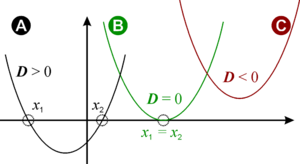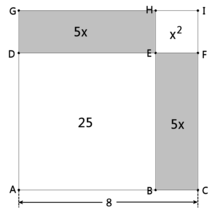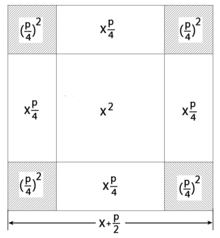Quadratic equation
A quadratic equation is an equation that can be expressed in the form
with 



Their solutions can be calculated using the formula
determine. In the domain of real numbers the quadratic equation can have no, one or two solutions. If the expression under the root is negative, no solution exists; if it is zero, one solution exists; if it is positive, two solutions exist.
The left-hand side of this equation is the term of a quadratic function (more generally, a second-degree polynomial), 

General form - Normal form - Zero form
The general form of the quadratic equation is
Here 


The equation is in normal form if 

and
the normal form can thus be written as
If one side of an equation is 0, it is also called zero form.
In the following, quadratic equations with real numbers as coefficients 




Solutions of the quadratic equation with real coefficients
A solution of the quadratic equation is a number that satisfies the equation when substituted for 
Number of real zeros
The number of solutions can be determined with the help of the so-called discriminant 


The graph shows the relationship between the number of real zeros and the discriminant:
- A Discriminant positive: The parabola has two intersections with the
axis, so there are two distinct real zeros
and
- B discriminant zero: The parabola has exactly one point of contact with the
axis, namely its vertex. Thus, there is exactly one (double) real solution. The quadratic equation
reduced to the form
- C Discriminant negative: The parabola has no intersection with the
axis, there are no real solutions of the quadratic equation. If we allow complex numbers as the basic set for the solutions, we get two different complex solutions. These are conjugate to each other, that is, they have the same real part and their imaginary parts differ only by the sign.
Simple special cases
If the coefficient of the linear element 

Missing linear element
The purely quadratic equation 

The solutions are
In the case 

For example, the equation 


The case 





Missing constant link
From the equation 




For example, the equation 

Equation in vertex form
The vertex shape
is a variation of the pure quadratic equation 


For 
By adding 

For 

Example:
Solve with quadratic complement
When solving with quadratic addition, the binomial formulas are used to take a quadratic equation in general or normal form to the vertex form, which can then be easily solved.
One uses the first or second binomial formula in the form
To do this, the quadratic equation is transformed so that the left side has the form 



This is best explained with a concrete numerical example. The following quadratic equation is considered
First, the equation is normalized by dividing by the conductance coefficient (here 3):
The constant element (here 6) is subtracted on both sides:
Now follows the actual quadratic addition: The left side must be completed in such a way that a binomial formula (here the second one) can be applied backwards. The 


The left side is transformed according to the binomial formula, the right side is simplified:
This leads to

so to the two solutions 
General solution formulas
One can also solve quadratic equations by using one of the general solution formulas derived using quadratic addition.
Solution formula for the general quadratic equation (a-b-c formula)
The solutions of the general quadratic equation 
The formula is colloquially called the "midnight formula" in parts of Germany and Switzerland because students are supposed to be able to recite it even if you wake them up at midnight and ask them for the formula. In Austria, the expression große Lösungsformel is commonly used.
Alternative forms
Alternative formulations of the a-b-c formula, more similar to the p-q formula discussed below, are:
If you write the quadratic equation in the form
(i.e. with β 
By extending the a-b-c formula with the term 




Solution of the a-b-c formula with negative discriminant
If the discriminant 



Derivation of the a-b-c formula
From the general form, transforming by the method of quadratic addition yields:
Calculation example
Given is the quadratic equation

Here 


Solution formula for the normal form (p-q formula)
In the presence of the normal form 
In Austria, this formula is known as the small solution formula.
Solution of the p-q formula with negative discriminant
As with the a-b-c formula, if 
Derivation of the p-q formula
The formula is obtained from the normal form of the quadratic equation by quadratic addition:
Another way to derive the formula is to set in the a-b-c formula 


Decomposition into linear factors
The solutions can be used to decompose the quadratic normalized polynomial into linear factors:
and the non-standardized in
Vieta set
If the quadratic equation is in normal form and has the solutions 

By comparing coefficients, we obtain Vieta's theorem

In particular, if 







Numerical calculation
If the solutions are determined numerically and differ from each other by orders of magnitude, the problem of cancellation can be avoided by the following variation of the above formulas:
Here has 


Examples
Calculation example
For the equation
the following solutions result according to the a-b-c formula

so 
To use the p-q formula, the general form is first converted to normal form by dividing the equation by 4:
The p-q formula gives the solutions

thus also 
Using the decompositions 

More examples
For the discriminantholds: the two real solutions
and
The discriminant is. The (double) real solution is
There are no real solutions, because the discriminant is negative. The complex solutions result inand

Position of the parabolas and effects on the number of zeros
Generalizations
Complex coefficients
The quadratic equation
with complex coefficients 



The solutions can be calculated as in the real case by quadratic addition or with the solution formulas given above. In general, however, a square root of a complex number must be calculated.
Example
For the quadratic equation
the discriminant has the value 

Quadratic equations in general rings
In general, in abstract algebra, an equation of the form
with elements p, q of a body or ring is a quadratic equation. In solids and more generally in integrality domains it has at most two solutions, in arbitrary rings it can have more than two solutions.
If solutions exist, then they are also obtained in commutativerings with the p-q formula, if the characteristic of the ring is not equal to 2. Here, however, all possible square roots of the discriminant have to be considered. For a finite body 


Example
The quadratic equation
has in the residue class ring 
History
Already 4000 years ago in the Old Babylonian Empire problems were solved which are equivalent to a quadratic equation. For example, the clay tablet archived under the inventory number BM 34568 in the British Museum, according to the cuneiform translation succeeded by Otto Neugebauer in the 1930s, contains as the ninth problem the question of the side lengths of a rectangle, where the sum of length and width is 14 and whose area is equal to 48.
Although the solution path documented on the clay tablet does not reveal any reasoning, it does reveal intermediate values, as they also appear in the usual solution formula or equivalent geometric considerations:
"Length and width added is 14 and 48 is the area.
The sizes are not known. 14 times 14 (is) 196. 48 times 4 (is) 192.Subtract
192 from 196 and you are left with 4. What times what should
I take to (get) 4? 2 times 2 (is) 4. Subtract 2 from 14 and you are left with 12.
12 times ½ (is) 6. 6 is the width. To 2 you will add 6, 8 it is. 8 (is) the length."
- BM 34568#9, translation after Otto Neugebauer (1937). S. 18.
The intermediate values listed in the text, which are notated on the clay tablet in the Babylonian sexigesimal system, also result when the associated quadratic equation 
According to Høyrup, it can be assumed that the solution path followed by the Babylonians for the cited and similar tasks was geometrically motivated, as were the tasks themselves.
The ancient Greeks solved various geometrical problems that are equivalent to quadratic equations. For example, in Euclid's Elements one finds the problem:
"To divide a line so that the rectangle that makes the whole line with one part is equal to the square over the other part."
- Euclid: Elements. Volume II, Task 11
The task corresponds in today's notation to the equation

which can be transformed to the equation
In the book Brāhmasphuṭasiddhānta ("Perfection of the Teaching of Brahma") by the Indian scholar Brahmagupta, written around 628 AD, solution methods for quadratic equations were described verbally. Brahmagupta already used negative numbers and their calculation rules such as
"The product of a negative and a positive is negative, of two negatives is positive, of two positives is positive; the product of zero and a negative, of zero and a positive, or of two zeros is zero."
- Brahmagupta: Brāhmasphuṭasiddhānta. Chapter XVIII, verse 33.
This enabled Brahmagupta to avoid case distinctions when he arrived at the quadratic equation, which today is known in the form
with
noted, described the following solution path:
"Using the mean [number] [meant: the coefficient of the unknowns, i.e.,
], reduce the square root of the absolute value multiplied by four times the square [meant: coefficient
unknowns] and increased by the square of the mean number; divide the remainder by twice the square [meant: coefficient
]. [The result] is the mean [number] [meant: the unknown
]"
- Brahmagupta, Brāhmasphuṭasiddhānta, Chapter XVIII, Verse 44.
This corresponds to the solution formula
Like the "Arabic"-Indian numerals, the findings of the Indian scholars found their dissemination and further development via Islamic scientists. A particularly prominent role was played by the mathematician Al-Chwarizmi, whose book al-Kitāb al-muḫtaṣar fī ḥisāb al-ğabr wa-ʾl-muqābala ("The Concise Book on Computational Procedures by Complementing and Equalizing"), written around 825 CE, contains for the first time general techniques for handling equations, albeit still described verbally. With the equivalent transformations of equations, which Al-Chwarizmi described in detail, any quadratic equation could be reduced to one of six types. Six types were necessary because Al-Chwarizmi, unlike Brahmagupta, did not use negative numbers.
Al-Chwarizmi's book contains a geometric solution procedure for all types by means of a numerical example, so that only positive solutions are possible. In the following list root means the searched solution 



- As for the assets that are equal to the roots (today:
),
- As for the assets that are equal to the number (today:
),
- As for the roots that are equal to a number (today:
),
- As for the assets and the roots, which are equal to the number (today:
),
- As for the assets and the number equal to the roots (today:
) and
- As for the roots and the number equal to the asset (today:
).
To solve the quadratic equations, al-Chwarizmi did not use equivalent transformations, i.e., algebraic reasoning, but geometric arguments, following the Greek tradition. As an example, the equation as it appears in al-Chwarizmi,
can be solved 

















In Heron of Alexandria and also in al-Chwarizmi, the solution of
described verbally; in today's spelling as
However, Heron adds the Euclidean way as a geometrical justification.
Around 1145 Robert of Chester and a little later Gerhard of Cremona translated the writings of al-Chwarizmi into Latin.
This brought the classification and geometric solution methods to Europe.
Michael Stiefel wrote the book Arithmetica integra in 1544 AD, which builds on the book Behend vnnd Hubsch Rechnung durch die kunstreichen regeln Algebre so gemeincklich die Coss genannt werden by Christoph Rudolff. The author manages to avoid the case distinction for quadratic equations by using negative numbers. But he does not allow negative numbers as solutions yet, because he considers them absurd.
A new approach to solving a quadratic equation was offered by Vieta's root theorem, published posthumously in 1615 in his work De Aequationem Recognitione et Emendatione Tractatus duo.
In 1637, René Descartes described a method for solving quadratic equations with a compass and ruler in his paper La Géométrie. He went on to show that equations of higher degree cannot generally be solved exclusively with compass and ruler.
See also
- Linear equation
- Cubic equation
- Quartic equation
Search within the encyclopedia


































![{\begin{array}{rcll}ax^{2}+bx+c&=&0&|-c\\[1ex]ax^{2}+bx&=&-c&|{}\cdot 4a\\[1ex]4a^{2}x^{2}+4abx&=&-4ac&|+b^{2}{\text{ (quadratische Ergänzung)}}\\[1ex](2ax)^{2}+2\cdot 2ax\,b+b^{2}&=&b^{2}-4ac&|{\text{ Umformen mit binomischer Formel}}\\[1ex](2ax+b)^{2}&=&b^{2}-4ac&|\pm {\sqrt {\quad }}\\[1ex]2ax+b&=&\pm {\sqrt {b^{2}-4ac}}&|-b\\[1ex]2ax&=&-b\pm {\sqrt {b^{2}-4ac}}&|:(2a)\\[1ex]x&=&{\dfrac {-b\pm {\sqrt {b^{2}-4ac}}}{2a}}&\end{array}}](https://www.alegsaonline.com/image/5d03d32cc54fca36f4359c43d82ce1711a8cb4e9.svg)


![{\displaystyle {\begin{array}{rcll}x^{2}+px+q&=&0&|-q\\[1ex]x^{2}+px&=&-q&|+\left({\dfrac {p}{2}}\right)^{2}{\text{ (quadratische Ergänzung)}}\\[1ex]x^{2}+2\cdot {\dfrac {p}{2}}\ x+\left({\dfrac {p}{2}}\right)^{2}&=&\left({\dfrac {p}{2}}\right)^{2}-q&|{\text{ binomische Formel}}\\[1ex]\left(x+{\dfrac {p}{2}}\right)^{2}&=&\left({\dfrac {p}{2}}\right)^{2}-q&|{\text{ Wurzel ziehen}}\\[1ex]\left|x+{\dfrac {p}{2}}\right|&=&{\sqrt {\left({\dfrac {p}{2}}\right)^{2}-q}}&|{\text{ Betrag auflösen}}\\[1ex]x+{\dfrac {p}{2}}&=&\pm {\sqrt {\left({\dfrac {p}{2}}\right)^{2}-q}}&|-{\dfrac {p}{2}}\\[1ex]x&=&-{\dfrac {p}{2}}\pm {\sqrt {\left({\dfrac {p}{2}}\right)^{2}-q}}\end{array}}}](https://www.alegsaonline.com/image/0448f3274d478a48dfb6b9359f160992af360ae2.svg)




























